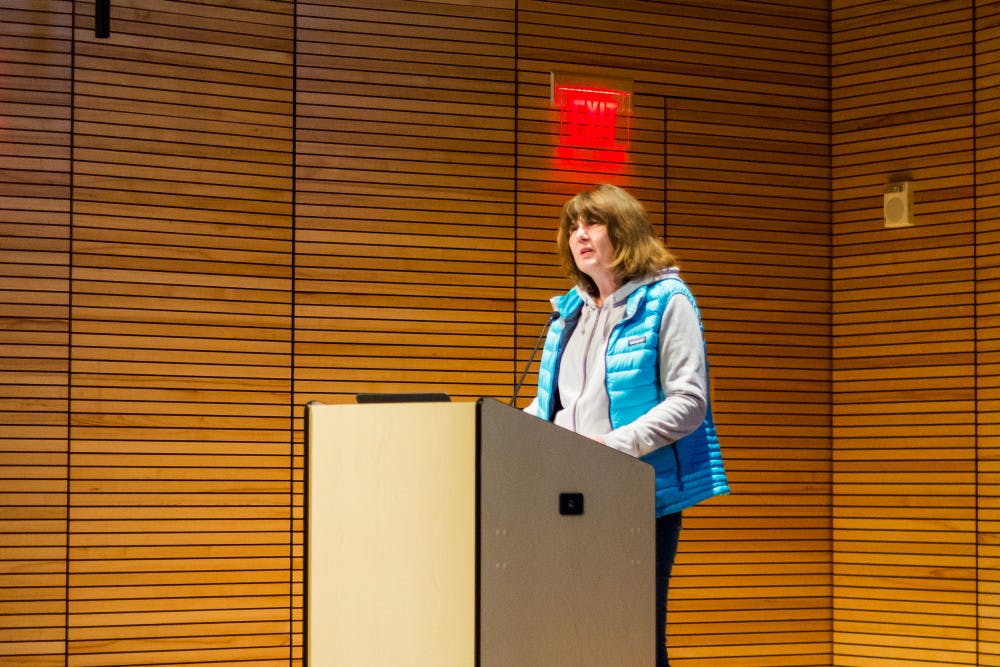In her talk Wednesday night, artist and curator Michelle Grabner described her art as a way to address patterns, repetition and boredom. She also described her curating style as a way to create opportunities for artists.
Grabner used Eugene Von Bruenchenhein to describe an artist completely opposite from herself. Bruenchenhein was “horrified of the ordinary” and “spent all of his time in the spectacular,” creating thrones and towers from chicken and turkey bones, Grabner said.
Grabner prefers patterns and order. At the start of her career, Grabner was fresh out of graduate school, loaded with student debt and struggling to get studio time. She needed to examine the order and repetition in her own life, so she looked to patterns and simple backdrops such as window curtains for inspiration, she said.
Grabner created indexical pieces, stretching blankets over a panel and using paint to fill in the spaces created by the figure beneath. Grabner “sees the drama” in these pieces, and it “gets her giddy,” she said. Grabner moved away from indexes and toward archimedes spirals around 2003, but her work was still focused on order and patterns.
Years later, Grabner took her “crusty, old paintings” from her work with indexes, and she cast them in bronze to monumentalize them. “Here I have this body, this material thing … in relationship to something that I’m after — this abstraction,” Grabner said, referring to the abstractions of boredom and time. The bronze pieces look like holey quilts solidified in metal and hung up to dry. They reflect the idea that within boredom, someone can stretch time, play with time and make it elastic, Grabner said.
Grabner has recently been thinking about criticality, saying, “I have been very fed up with the suspicious critique,” which Grabner describes as the idea that it is up to critics to unearth the meaning of an art piece. There are so many options for interpreting works of art, Grabner added.
As a visual arts concentrator, Nadya Kim ’17 was inspired by how Grabner dealt with one extremely harsh review in the New York Times that called Grabner a “soccer mom” in 2014. In response to the label, Grabner created a series of pieces using soccer balls as materials. “My work and how people would perceive it is always a concern to me,” Kim said, adding that it was inspiring to see how Grabner recovered from the review.
“The Suburban” is an artistic exhibition space that Grabner co-created in the Oak Park neighborhood in Chicago in 2009. “The Suburban” attracts the work of artists from all over the world and all different stages of recognition, “some people that you know, these fancy-ass artists, but also artists from New Zealand that you’ve never heard of, or St. Louis or from Madison, Wisconsin,” Grabner said.
Grabner approaches curating from an artist-centric position, which Minae Choi ’19 said she appreciated hearing in the talk. Grabner thinks exhibitions are less about the institution or the audiences involved and more about the artists themselves, she said.
Grabner tries to present artists with sites for their work that will allow them to grow artistically and stretch how they think about the world, she said. She gave Jessica Jackson Hutchins an abandoned Christian science reading room in Pendleton, Oregon to install her work for the 2016 Portland Biennial. Grabner described the experience as a chance for the artist to stretch her relationship to materials and to think about the site and context of her art in a new way.
Exhibitions such as the Whitney Biennial were once considered the best place to go if someone wanted to learn the current trends in the nation’s art, Grabner said. She co-curated the Whitney Biennial at the Whitney Museum of American Art in 2014.
“I was not afraid to organize the bigger galleries of the Whitney Biennial around these bigger cliches, one of which is affect and materiality, one of which is appropriation,” Grabner said. She organized and presented her portion of the building’s gallery as a reflection of what artists were currently thinking about in their lives and world, she said.
The process of co-curating the exhibition showed Grabner that when it comes to art, “the facts are not the truth.” Grabner explained that art is about interpretation. Someone can understand a piece of art differently from someone else and reshape its meaning, she said.





